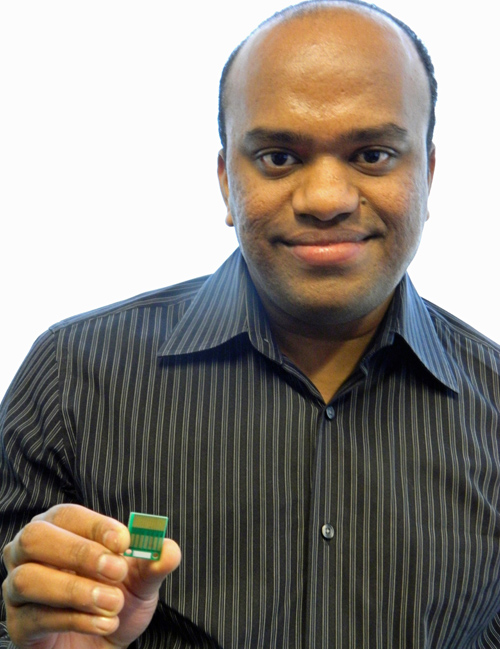
You probably brushed your teeth this morning. And you probably didn’t think much about the reasons for that part of your daily routine, but engineering professor Suresh Neethirajan would tell you that brushing is a good way to detach bacteria from the surfaces of your teeth, helping to prevent cavities.
But what if those bacteria could be prevented from sticking to your teeth in the first place? One of Neethirajan’s research projects is about improving our understanding of how bacteria attach themselves to surfaces – what he calls the “adhesion kinetics” of bacteria. Once we understand that, there is potential to develop extremely thin films that could coat medical instruments used in surgery, prosthetics or medical implants, or even human teeth, to prevent infection.
To study this, he’s developed tiny devices made of silicon in which bacteria can be grown and then studied under optical and laser-scanning microscopes.
That’s just one of several projects Neethirajan is working on. He grew up in India and did his undergraduate degree there, but completed his graduate work at the University of Manitoba. There he used nanotechnology to develop sensors that could be inserted in a device the size of a sugar cube and added to grain storage bins.
“If insects get into these bins, or if the grain spoils, that means a major loss for the farmer,” says Neethirajan. “These sensors can detect chemicals such as carbon dioxide that are released when insects start eating the grain or the metabolites released when a fungus infects the grain. The sensor can identify exactly what the problem is so the farmer can respond properly.”
The sensor, which has been patented, also has the ability to send electronic signals through the Internet. “One of my students is working on developing a wireless unit so that the farmer doesn’t even have to be near the farm – he could be vacationing in Florida – but he’d be notified of, for example, a fungus in the grain bin and could call to have the treatment started,” he says.
During his student years, Neethirajan attended summer school at Oxford University and spent some time in Grenoble, France. After completing his studies in Manitoba, he traveled again – to Tokyo, where he worked at the Japan Food Institute under a Japan Society for the Promotion of Science Fellowship. “I was doing research to create new value for minor food crops such as buckwheat and quinoa,” he says.
These crops are highly nutritious, but not grown as often as the better-known grains. Neethirajan’s work sought to group and map the chromosomes of these grains, and to find ways to use the grains in the cosmetics and biofuel industries.
He then completed a post-doctoral stint at the Oak Ridge National Laboratory in the U.S., where he built microfluidic devices and developed nanoscale analytical techniques for studying plant-microbe interactions. This well-known facility was at one time headed up by Albert Einstein and was where the atomic bomb was developed during World War II. The laboratory still has a research budget of some $1.5 billion. “I wasn’t in the ‘top secret’ area,” he jokes.
Now that he’s at U of G, Neethirajan is embarking on “very ambitious” projects to use nanoscale devices, technologies and methods to study biological and agricultural systems. These technologies, for example, are very valuable in studying bacteria.
This better understanding of bacteria may help in determining appropriate doses of antibiotics, he adds. “Right now we usually take higher doses of antibiotics than we really need, just to be sure,” he explains. “Using microfluidics to mimic the cellular environment, we can study bacteria and determine exactly what the minimum effective dose would be.”
Neethirajan also envisions the “nano-cellphone.” Ten or 15 years ago, he points out, a cellphone was roughly the size of a brick. Today it fits in the palm of your hand. It can get smaller, Neethirajan says. “Now we can make wires from DNA that we can pass electricity through. And the cellphone won’t need to be recharged – it will run on solar energy using bacteria to convert the energy of light to fuel the phone can use.”
Perhaps not surprising given his love of world travel, Neethirajan is a licensed private pilot who flies single-engine planes. He also likes to go sky-diving at least once a year. “It’s really thrilling,” he says. “Sometimes you tumble in free fall when you first jump out of the plane – that’s the biggest thrill. Then you open the parachute and it’s just a smooth glide to the ground.”